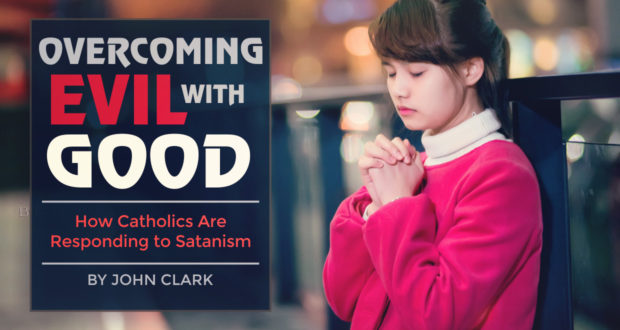Many Catholics in America are now aware that a number of sacrilegious “black masses” have taken place across the country. Even if you have tried to avoid the issue, it tends to find you. And these proceedings are not lost on the press; indeed, the media seem captivated by them. But, with all due respect to the reporters, the events themselves are not what is fascinating.
Sin is boring. What is fascinating is the response of Catholics. What is even more fascinating is the response of God.
It seems like the larger the press coverage is of such happenings, the larger the number of Catholics who respond by Eucharistic adoration, fasting, and prayer. That is how Catholics respond. Undoubtedly, at these events, some people pass by, see the Catholics who are praying the Rosary on their knees, and mock them.
Catholics keep praying.
Others, indifferent to their prayers, ignore these Catholics altogether.
Catholics keep praying.
Still others, who had no plans of praying the Rosary that day, or perhaps ever, decide to join in and pray with them.
Catholics keep praying.
Though I haven’t prayed outside of one of these events, for the first time in my life, I began making a weekly Holy Hour in reparation for them a few months ago. It was time. Because of my attendance at Holy Hours, my love of God became stronger. My marriage became stronger. My faith became stronger. I became stronger.
Collectively, ours is a response and answer to Romans 12:21: “Do not be overcome by evil, but overcome evil with good.”
And what is the response of God? Love.
Ecclesiastical history illustrates that God’s love and mercy extend not only to those who love Him, but also to those who hate Him. The Church offers us proof of this in many ways, yet there is a man whose story evidences God’s love and should give us hope for others. His name was Bartolo Longo.
Longo was raised in the Catholic Faith as child in Italy in the 1860’s, but fell into the spiritual blindness of satanism as a young adult. In fact, he went so far as to become a satanic priest. However, he eventually saw the error of his ways and returned to the Catholic Church.
Once his eyes were opened, Longo then became aware of the fact that much of Italy was in the clutches of atheism, occultism, and satanism. Recognizing that he was called to evangelize, Longo sensed the cure for a world drifting into satanism and occultism: that cure was the devotion to Mary and the Rosary.
Today, Longo is known as one of the Church’s greatest promoters of the Rosary, being cited by Pope Saint John Paul II in Rosarium Virginis Mariae as “the apostle of the Rosary.” Longo was beatified by Pope Saint John Paul II in 1980.
In 2008, Pope Benedict XVI, recognizing the inspiration of Longo, said:
The episode of Bartolo Longo’s spiritual crisis and conversion appears very relevant today. In fact, in the period of his university studies in Naples, influenced by immanentist and positivist philosophers, he had drifted from the Christian faith. He had become a militant anti-clerical, and even indulged in spiritualistic and superstitious practices. His conversion, with the discovery of God’s true Face, contains a very eloquent message for us since, unfortunately, such tendencies are not lacking in our day… I am pleased to emphasize that like St. Paul, Bartolo Longo was transformed from persecutor to apostle: an apostle of Christian faith, of Marian devotion and, in particular, of the Rosary, in which he found a synthesis of the whole Gospel.
Longo’s conversion is evidence of the love of God. It also gives us hope that sainthood is possible for anyone on earth.
Catholics, keep praying.
Header Image CC Mỳ Tôm Hai Trứng

 Seton Magazine Catholic Homeschool Articles, Advice & Resources
Seton Magazine Catholic Homeschool Articles, Advice & Resources
